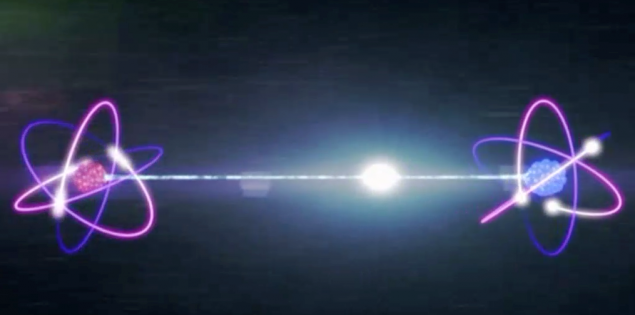Can atoms be in two places at once?
 Bashny.Net
Bashny.Net

Is it possible to simultaneously score a goal and not get blocked? In the world of the smallest objects, Yes: in accordance with the predictions of quantum mechanics, microscopic objects can choose different paths at the same time. The world of macroscopic objects obey different rules: the football always moves in a certain direction. But there may be loopholes. Physicists from the University of Bonn have created an experiment that should verify this. The first experiment will show whether the cesium atoms to choose two paths simultaneously.
Almost 100 years ago physicists Werner Heisenberg, Max born and Erwin Schrodinger created a new area of physics: quantum mechanics. The objects of the quantum world — according to quantum theory — it does not move along a well defined path. Rather, they can simultaneously take different paths and end up in different places. Physicists call it the quantum superposition.
At the atomic level it looks like objects are strictly obey quantum-mechanical laws. For many years, many experiments have confirmed the predictions of quantum mechanics. But in our macroscopic experience, we observe how the soccer ball chooses only one path. He will never fall into the net and bounces on the rod at the same time. Why?
"There are two different interpretations, says Dr. Andrea Alberti from the Institute of applied physics of the University of Bonn. Quantum mechanics allows the superposition of large macroscopic objects. But the state of superposition is very fragile: even the fact that we are observing the ball, can destroy the superposition and force the ball to choose a specific path".
Can large objects play by different rules?

Suppose that we have two domes; one of them sitting cat (a). We don't know exactly how. We raised right dome (b), and find that it is empty. Thus, we conclude that the cat must be under the left dome, and do not touch him. If we raised left dome, we would have disturbed the cat, and the measurement is lost. In the world of macrorealism this scheme of measurement does not affect the state of the cat, he would remain calm all the time. In the quantum world, however, a negative measurement that detects the position of the cat (b), and destroys a state of superposition and affects the outcome of the experiment.
Could also be that footballs obey completely different rules than those that apply to single atoms. "Let's talk about macroregulation view of the world — govori Alberti. In accordance with this interpretation, the ball always moves along a certain trajectory, independent of our observation, and differs from the atom."
In collaboration with Clive emary of the University of hull in the U.K., the Bonn team has come up with the pilot scheme, which will help to identify the correct interpretation. "The challenge is to develop a scheme of measuring positions of the atoms, which will allow you to macroregulation falsify the theory," adds Alberti.
Description of the experiment appeared in the journal Physical Review X, physics captured a single cesium atom with two optical tweezers and moved it in two different directions. In the world of necrorealist atom would end up in one of the two end points. From the point of view of quantum mechanics, the atom will be in a superposition of two positions.
"We then used indirect measurements that can determine the final position of the atom in the most gentle way possible," says graduate student Karsten, Robins. Even such an indirect and soft dimension significantly changes the results of the experiment. This observation excludes — falsificare, as told to Karl Popper — the possibility that the cesium atoms are subject microrelations theory. Instead, the experimental findings of the team from Bonn and fits in perfectly with the interpretation based on superposition States that get destroyed when carrying out indirect measurements. All we can do is recognize that the atom can really choose different paths at the same time.
"It does not prove that quantum mechanics working with large objects, says Alberti. The next step will be the separation of the two positions of the atom of cesium by a few millimeters. If we still find a superposition in this experiment, macroelasticity theory seriously shaken".
Source: hi-news.ru
Tags
See also
String theory: what does God think?
To understand the universe: what is the quantum of and why its so fond of psychics
9 important facts about quantum computers, which will help you understand what it is
11 new areas of science, which is important to know
You must have the strength and honesty to be where you are
15 facts, things and events in the world around us, very similar to the mystique
















